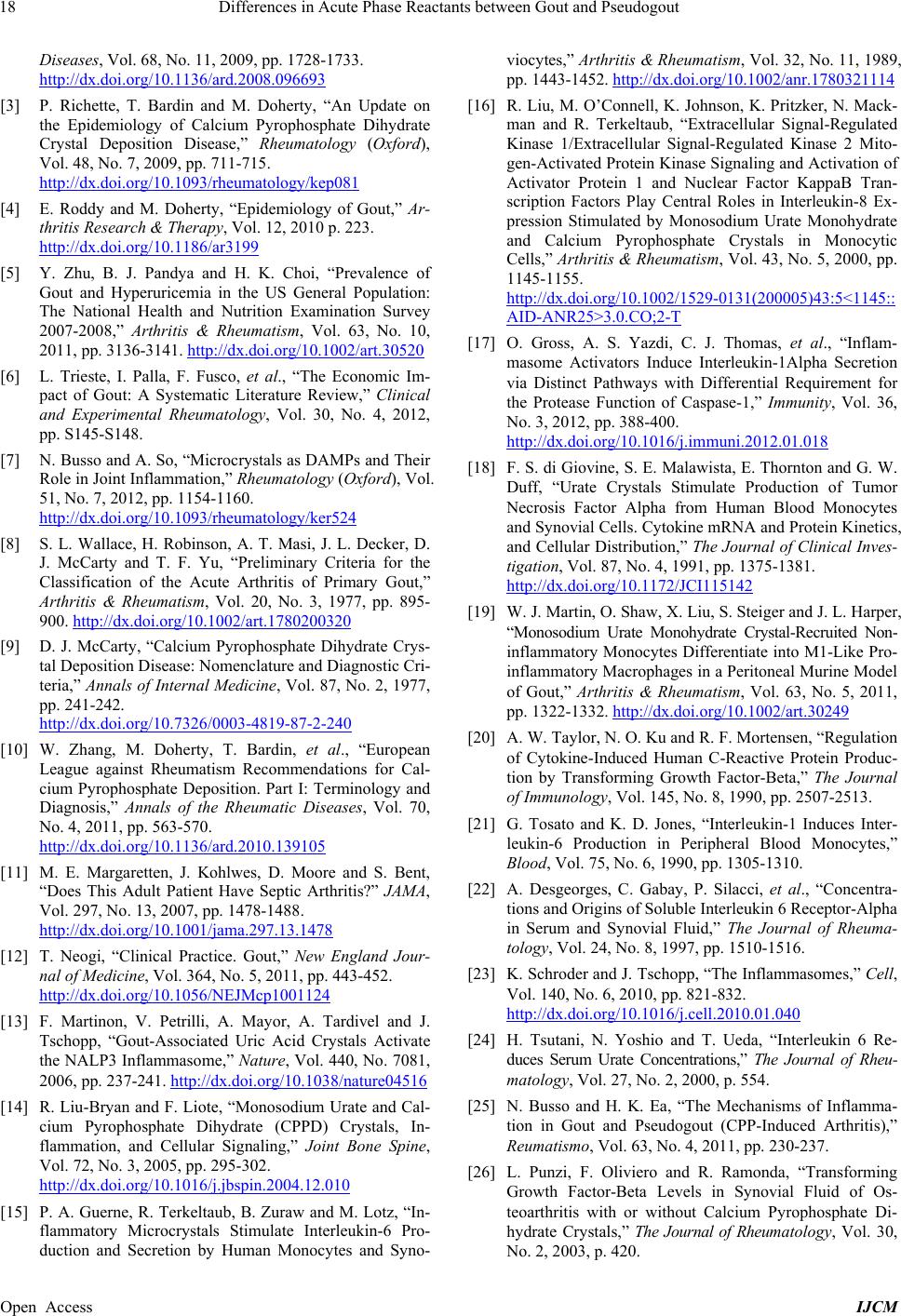
Differences in Acute Phase Reactants between Gout and Pseudogout
Open Access IJCM
18
Diseases, Vol. 68, No. 11, 2009, pp. 1728-1733.
http://dx.doi.org/10.1136/ard.2008.096693
[3] P. Richette, T. Bardin and M. Doherty, “An Update on
the Epidemiology of Calcium Pyrophosphate Dihydrate
Crystal Deposition Disease,” Rheumatology (Oxford),
Vol. 48, No. 7, 2009, pp. 711-715.
http://dx.doi.org/10.1093/rheumatology/kep081
[4] E. Roddy and M. Doherty, “Epidemiology of Gout,” Ar-
thritis Research & Therapy, Vol. 12, 2010 p. 223.
http://dx.doi.org/10.1186/ar3199
[5] Y. Zhu, B. J. Pandya and H. K. Choi, “Prevalence of
Gout and Hyperuricemia in the US General Population:
The National Health and Nutrition Examination Survey
2007-2008,” Arthritis & Rheumatism, Vol. 63, No. 10,
2011, pp. 3136-3141. http://dx.doi.org/10.1002/art.30520
[6] L. Trieste, I. Palla, F. Fusco, et al., “The Economic Im-
pact of Gout: A Systematic Literature Review,” Clinical
and Experimental Rheumatology, Vol. 30, No. 4, 2012,
pp. S145-S148.
[7] N. Busso and A. So, “Microcrystals as DAMPs and Their
Role in Joint Inflammation,” Rheumatology (Oxford), Vol.
51, No. 7, 2012, pp. 1154-1160.
http://dx.doi.org/10.1093/rheumatology/ker524
[8] S. L. Wallace, H. Robinson, A. T. Masi, J. L. Decker, D.
J. McCarty and T. F. Yu, “Preliminary Criteria for the
Classification of the Acute Arthritis of Primary Gout,”
Arthritis & Rheumatism, Vol. 20, No. 3, 1977, pp. 895-
900. http://dx.doi.org/10.1002/art.1780200320
[9] D. J. McCarty, “Calcium Pyrophosphate Dihydrate Crys-
tal Deposition Disease: Nomenclature and Diagnostic Cri-
teria,” Annals of Internal Medicine, Vol. 87, No. 2, 1977,
pp. 241-242.
http://dx.doi.org/10.7326/0003-4819-87-2-240
[10] W. Zhang, M. Doherty, T. Bardin, et al., “European
League against Rheumatism Recommendations for Cal-
cium Pyrophosphate Deposition. Part I: Terminology and
Diagnosis,” Annals of the Rheumatic Diseases, Vol. 70,
No. 4, 2011, pp. 563-570.
http://dx.doi.org/10.1136/ard.2010.139105
[11] M. E. Margaretten, J. Kohlwes, D. Moore and S. Bent,
“Does This Adult Patient Have Septic Arthritis?” JAMA,
Vol. 297, No. 13, 2007, pp. 1478-1488.
http://dx.doi.org/10.1001/jama.297.13.1478
[12] T. Neogi, “Clinical Practice. Gout,” New England Jour-
nal of Medicine, Vol. 364, No. 5, 2011, pp. 443-452.
http://dx.doi.org/10.1056/NEJMcp1001124
[13] F. Martinon, V. Petrilli, A. Mayor, A. Tardivel and J.
Tschopp, “Gout-Associated Uric Acid Crystals Activate
the NALP3 Inflammasome,” Nature, Vol. 440, No. 7081,
2006, pp. 237-241. http://dx.doi.org/10.1038/nature04516
[14] R. Liu-Bryan and F. Liote, “Monosodium Urate and Cal-
cium Pyrophosphate Dihydrate (CPPD) Crystals, In-
flammation, and Cellular Signaling,” Joint Bone Spine,
Vol. 72, No. 3, 2005, pp. 295-302.
http://dx.doi.org/10.1016/j.jbspin.2004.12.010
[15] P. A. Guerne, R. Terkeltaub, B. Zuraw and M. Lotz, “In-
flammatory Microcrystals Stimulate Interleukin-6 Pro-
duction and Secretion by Human Monocytes and Syno-
viocytes,” Arthritis & Rheumatism, Vol. 32, No. 11, 1989,
pp. 1443-1452. http://dx.doi.org/10.1002/anr.1780321114
[16] R. Liu, M. O’Connell, K. Johnson, K. Pritzker, N. Mack-
man and R. Terkeltaub, “Extracellular Signal-Regulated
Kinase 1/Extracellular Signal-Regulated Kinase 2 Mito-
gen-Activated Protein Kinase Signaling and Activation of
Activator Protein 1 and Nuclear Factor KappaB Tran-
scription Factors Play Central Roles in Interleukin-8 Ex-
pression Stimulated by Monosodium Urate Monohydrate
and Calcium Pyrophosphate Crystals in Monocytic
Cells,” Arthritis & Rheumatism, Vol. 43, No. 5, 2000, pp.
1145-1155.
http://dx.doi.org/10.1002/1529-0131(200005)43:5<1145::
AID-ANR25>3.0.CO;2-T
[17] O. Gross, A. S. Yazdi, C. J. Thomas, et al., “Inflam-
masome Activators Induce Interleukin-1Alpha Secretion
via Distinct Pathways with Differential Requirement for
the Protease Function of Caspase-1,” Immunity, Vol. 36,
No. 3, 2012, pp. 388-400.
http://dx.doi.org/10.1016/j.immuni.2012.01.018
[18] F. S. di Giovine, S. E. Malawista, E. Thornton and G. W.
Duff, “Urate Crystals Stimulate Production of Tumor
Necrosis Factor Alpha from Human Blood Monocytes
and Synovial Cells. Cytokine mRNA and Protein Kinetics,
and Cellular Distribution,” The Journal of Clinical Inves-
tigation, Vol. 87, No. 4, 1991, pp. 1375-1381.
http://dx.doi.org/10.1172/JCI115142
[19] W. J. Martin, O. Shaw, X. Liu, S. Steiger and J. L. Harper,
“Monosodium Urate Monohydrate Crystal-Recruited Non-
inflammatory Monocytes Differentiate into M1-Like Pro-
inflammatory Macrophages in a Peritoneal Murine Model
of Gout,” Arthritis & Rheumatism, Vol. 63, No. 5, 2011,
pp. 1322-1332. http://dx.doi.org/10.1002/art.30249
[20] A. W. Taylor, N. O. Ku and R. F. Mortensen, “Regulation
of Cytokine-Induced Human C-Reactive Protein Produc-
tion by Transforming Growth Factor-Beta,” The Journal
of Immunology, Vol. 145, No. 8, 1990, pp. 2507-2513.
[21] G. Tosato and K. D. Jones, “Interleukin-1 Induces Inter-
leukin-6 Production in Peripheral Blood Monocytes,”
Blood, Vol. 75, No. 6, 1990, pp. 1305-1310.
[22] A. Desgeorges, C. Gabay, P. Silacci, et al., “Concentra-
tions and Origins of Soluble Interleukin 6 Receptor-Alpha
in Serum and Synovial Fluid,” The Journal of Rheuma-
tology, Vol. 24, No. 8, 1997, pp. 1510-1516.
[23] K. Schroder and J. Tschopp, “The Inflammasomes,” Cell,
Vol. 140, No. 6, 2010, pp. 821-832.
http://dx.doi.org/10.1016/j.cell.2010.01.040
[24] H. Tsutani, N. Yoshio and T. Ueda, “Interleukin 6 Re-
duces Serum Urate Concentrations,” The Journal of Rheu-
matology, Vol. 27, No. 2, 2000, p. 554.
[25] N. Busso and H. K. Ea, “The Mechanisms of Inflamma-
tion in Gout and Pseudogout (CPP-Induced Arthritis),”
Reumatismo, Vol. 63, No. 4, 2011, pp. 230-237.
[26] L. Punzi, F. Oliviero and R. Ramonda, “Transforming
Growth Factor-Beta Levels in Synovial Fluid of Os-
teoarthritis with or without Calcium Pyrophosphate Di-
hydrate Crystals,” The Journal of Rheumatology, Vol. 30,
No. 2, 2003, p. 420.